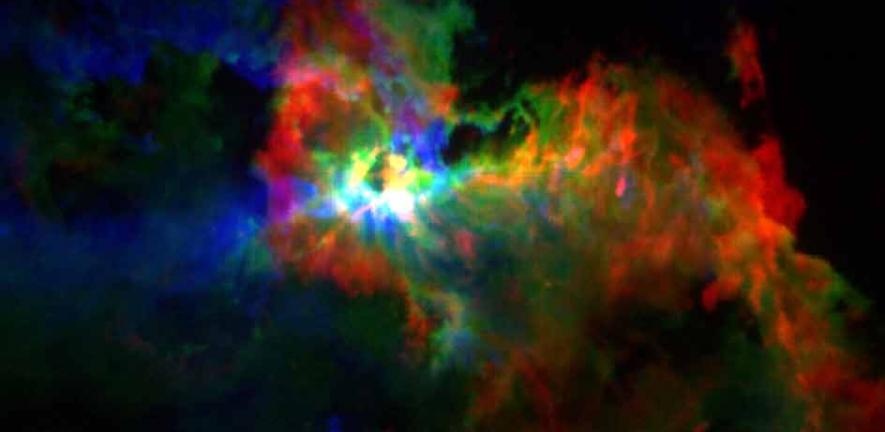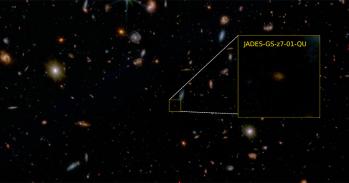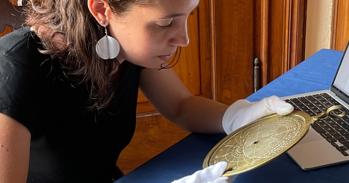
Looking deep inside the swirling dust clouds that make up stellar nurseries – the birth place of stars – can help unravel mysteries of the birth and evolution of galaxies like our own.
Looking deep inside the swirling dust clouds that make up stellar nurseries – the birth place of stars – can help unravel mysteries of the birth and evolution of galaxies like our own.
Although the picture of stellar birth outlined above is widely accepted, many key details remain to be understood.
After seven years of design, construction and testing, the first images of deep space are starting to arrive in Cambridge thanks to a pioneering radio receiver known as HARP. Astrophysicists at the University of Cambridge’s Cavendish Laboratory have led the development of the radio receiver, recently installing it on the James Clerk Maxwell Telescope (JCMT) in Hawaii. At 15 m in diameter, the JCMT is the largest telescope in the world operating at submillimetre wavelengths. The astrophysicists are now engaged in making the first scientific observations using HARP, with the aim of understanding the elusive origins of stars and planets in our galaxy.
Stellar birth
Over the past 20 years or so, astronomers have made remarkable breakthroughs in understanding how stars form. About 4.5 billion years ago, when the Universe was two thirds of its current age, a cloud of molecular gas in our galaxy collapsed to form the Sun and its planets. The events that led to this are believed to be similar to what we see in newly forming stars today.
Molecular clouds are complex objects. They are cold, heated only by the faint light of nearby stars and by the occasional cosmic ray. They are tenuous, containing only a few hundred molecules of molecular hydrogen per cubic centimetre – a significantly lower density than in the best laboratory vacuum. And their fate depends on the delicate balance between forces of gravity and pressure. Although the gravitational attraction between molecules in the cloud is feeble, within the densest parts of the clouds, called cores, the gravitational force can overcome the cloud’s weak pressure, and cloud collapse begins.
The collapse is fastest at the centre of the cloud core, where the material grows to high density and forms a hot protostar. These objects are deeply enshrouded in dust and therefore invisible to optical telescopes. Material from the cloud rains down onto the growing protostar, dragged in by gravity. Because cores in general possess a small amount of rotation before collapse, the infalling material carries this rotation inwards, which leads to the formation of a molecular gas disk rotating around the central protostar. So far, the collapse has taken a few hundred thousand years, a relatively brief time in astronomical contexts. As the collapse proceeds, bipolar jets of material are produced by the spinning disk and protostar, generating spectacular shock waves in the clouds. After a million years or so, the protostar’s growth ends, the disk is destroyed and a new star becomes visible to optical telescopes.
Mapping the molecular clouds
The molecular clouds of our own galaxy contain as much mass as a billion suns, and in these clouds about five new stars per year on average are created by gravitational collapse. Although the picture of stellar birth outlined above is widely accepted, many key details remain to be understood. The detailed physical structure of the clouds, including their temperature, density and velocity, remains poorly defined, and the processes that initiate the formation of cores and protostellar collapse are not understood.
The dramatic impact of outflows and winds from the newly formed protostars is also a matter of much debate. What are the processes that eventually terminate the build up of gas onto a protostar, and so set its final mass? And what are the conditions that lead to the creation of binary star and triple star systems?
To try to answer these questions, astronomers need to make precise observations of the conditions within molecular clouds. One of the main challenges to doing this is the coldness of the clouds, which weakens their emissions. Despite this, it is possible to detect molecules such as carbon monoxide and hydrogen cyanide in the clouds because they emit radio waves when they change their rotational state, producing characteristic ‘spectral lines’ that can be detected on Earth using specialised high-frequency radio receivers. But to do this, observations must be made from a high-altitude site, such as the 14,000 ft volcanic peak of Mauna Kea in Hawaii, home to the JCMT and HARP. At this location, the water content of the atmosphere is very low, permitting even the faint spectral line emission from molecular clouds to be detected. By scanning the telescope over interesting patches of sky, large-scale images are constructed.
The HARP radio array receiver has been designed and built at the Cavendish Laboratory to improve the speed at which astronomers can make their observations of molecular clouds. At its heart is a four-by-four array of superconducting tunnel junctions, cooled to 4ºC above absolute zero. HARP’s advantage is its speed: its highly sensitive array of detectors allows astronomers to map clouds of gas more than 25 times faster than previous systems used at the JCMT, meaning that bigger and more sensitive images can be made. This is key to revealing the properties of star-forming clouds in the galaxy in greater detail.
First impressions
The Cambridge team has recently finished the scientific commissioning of HARP, and the first images and spectra are starting to be taken. At the Cavendish Laboratory, the first complete set of data is currently being analysed: it is the largest and most detailed image of the spectacular Orion molecular cloud ever made at this wavelength.
Orion lies some 1400 light years from the Sun. It contains some of the most rapid star formation in the galaxy and the HARP image reveals incredible detail in the gas distribution and flows. The highly dynamic nature of the cloud has been revealed: large-scale gas motions pervade the cloud, and the race is on to understand how these arise and what their effect on the future evolution of the cloud will be.
Further leaps
The Cambridge team expects that they and astronomers worldwide will be busy acquiring data with HARP and carrying out detailed scientific analysis for at least the next five years. But they already have their sights on the next goal. The disks of gas that are known to spin around forming stars are too small to be resolved by HARP on the JCMT. Within these disks, material must spiral into the protostar, jets must be generated to drive the observed bipolar flows and planets are expected to condense. To make detailed images of these protoplanetary disks requires astronomers to use the technique of radio interferometry. In this technique, which won Cambridge astronomers Martin Ryle and Antony Hewish the 1974 Nobel Prize in Physics, signals from similar telescopes are combined to create images with much higher resolution than a single telescope.
In the Atacama Desert of northern Chile, on a barren plateau 17,000 ft high, the most ambitious radio interferometer ever built is coming to life: the Atacama Large Millimetre Array (ALMA). ALMA’s 66 radio antennas will be combined electronically to generate images of molecular gas clouds and protostars at unprecedented resolution.
ALMA is a collaboration between 17 countries worldwide. In Cambridge, astronomers have been involved in several aspects of ALMA’s planning and design. Of particular note is a system of radio receivers that monitor the water vapour in the atmosphere, which allows ALMA to correct the ‘twinkling’ of the radio sources caused by the Earth’s unstable atmosphere.
Construction of ALMA will be complete by 2012 and astronomers will then be able to make detailed images of protostars and protostellar disks, and start to understand the details of planet formation and disk evolution as never before. Using this technique, astronomers hope to make pin-sharp images of these objects and so understand better the detailed origin of our Sun and its planets.
For more information, please contact the author Dr John Richer (jsr@mrao.cam.ac.uk) at the Cavendish Laboratory.
This work is licensed under a Creative Commons Licence. If you use this content on your site please link back to this page.





